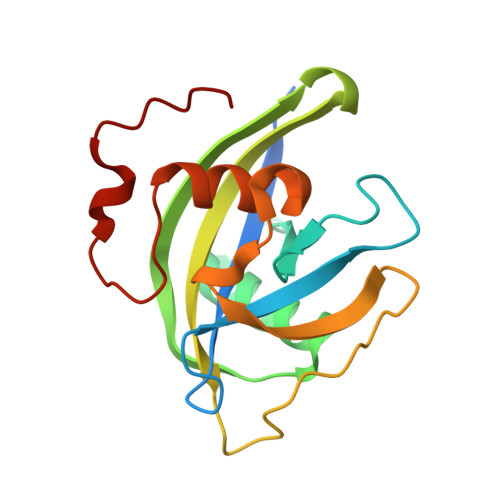Crystal structures of NUDT15 variants enabled by a potent inhibitor reveal the structural basis for thiopurine sensitivity.
Rehling, D., Zhang, S.M., Jemth, A.S., Koolmeister, T., Throup, A., Wallner, O., Scaletti, E., Moriyama, T., Nishii, R., Davies, J., Desroses, M., Rudd, S.G., Scobie, M., Homan, E., Berglund, U.W., Yang, J.J., Helleday, T., Stenmark, P.(2021) J Biological Chem 296: 100568-100568
- PubMed: 33753169
- DOI: https://doi.org/10.1016/j.jbc.2021.100568
- Primary Citation of Related Structures:
7B63, 7B64, 7B65, 7B66, 7B67 - PubMed Abstract:
The enzyme NUDT15 efficiently hydrolyzes the active metabolites of thiopurine drugs, which are routinely used for treating cancer and inflammatory diseases. Loss-of-function variants in NUDT15 are strongly associated with thiopurine intolerance, such as leukopenia, and preemptive NUDT15 genotyping has been clinically implemented to personalize thiopurine dosing. However, understanding the molecular consequences of these variants has been difficult, as no structural information was available for NUDT15 proteins encoded by clinically actionable pharmacogenetic variants because of their inherent instability. Recently, the small molecule NUDT15 inhibitor TH1760 has been shown to sensitize cells to thiopurines, through enhanced accumulation of 6-thio-guanine in DNA. Building upon this, we herein report the development of the potent and specific NUDT15 inhibitor, TH7755. TH7755 demonstrates a greatly improved cellular target engagement and 6-thioguanine potentiation compared with TH1760, while showing no cytotoxicity on its own. This potent inhibitor also stabilized NUDT15, enabling analysis by X-ray crystallography. We have determined high-resolution structures of the clinically relevant NUDT15 variants Arg139Cys, Arg139His, Val18Ile, and V18_V19insGlyVal. These structures provide clear insights into the structural basis for the thiopurine intolerance phenotype observed in patients carrying these pharmacogenetic variants. These findings will aid in predicting the effects of new NUDT15 sequence variations yet to be discovered in the clinic.
- Department of Biochemistry and Biophysics, Stockholm University, Stockholm, Sweden.
Organizational Affiliation:



















